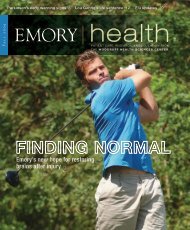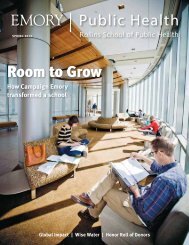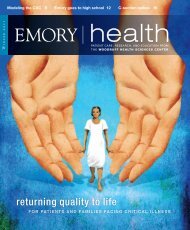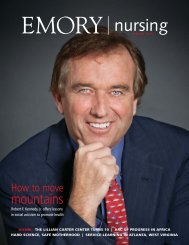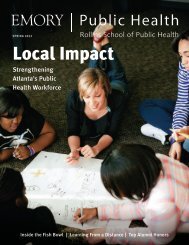extension - Woodruff Health Sciences Center - Emory University
extension - Woodruff Health Sciences Center - Emory University
extension - Woodruff Health Sciences Center - Emory University
You also want an ePaper? Increase the reach of your titles
YUMPU automatically turns print PDFs into web optimized ePapers that Google loves.
A publication of the Division of Physical Therapy, Department of Rehabilitation Medicine, <strong>Emory</strong> <strong>University</strong> School of Medicine<br />
<strong>extension</strong><br />
FALL 2010<br />
Reaching for a breakthrough<br />
Using oxygen deprivation therapy<br />
to restore limb function<br />
Tomorrow’s curriculum, today 4 Dual degrees of change 5 Bahrain exchange 6
from the director<br />
On behalf of the faculty, staff and students, I welcome you to Extension. While sum-<br />
mer is a time for rest and renewal, at <strong>Emory</strong> our summer was extremely busy.<br />
In early May, we graduated the Doctor of Physical Therapy Class of 2010 that in-<br />
cluded our first two DPT/MPH graduates and our second DPT/MBA graduate (see page<br />
5). Professor Steven Wolf of our faculty was chosen by the<br />
graduates to give the commencement address.<br />
In mid-June we matriculated the DPT Class of 2013, our<br />
biggest class ever, comprised of students from 23 states and<br />
Canada, 46 universities and 17 different majors. We also<br />
launched our enhanced curriculum with this new class (see<br />
page 4). We are proud to be leading the way with additional<br />
course offerings and content which parallel the goals of<br />
our profession and continue to prepare our students for<br />
the future.<br />
In order to continue to recruit the brightest and most<br />
committed students, we are mounting our first scholarship campaign. I ask that you<br />
make an investment in the <strong>Emory</strong> Doctor of Physical Therapy Program. About 6% of<br />
our alumni make a gift to our program on a regular basis. I challenge you to raise the<br />
participation rates among our alumni to 100%. Every dollar counts, and no gift is too<br />
small to count towards your participation in this important endeavor. For your conve-<br />
nience, a pledge form is enclosed. Should you wish to contribute online, please see<br />
page 9 of this magazine for the details.<br />
Our faculty makes it possible to fulfill our educational, clinical and scholarly endeav-<br />
ors, and to bolster these efforts we are excited to welcome Dr. Tami Phillips, Dr. Ainsley<br />
Rossi and Dr. Randy Trumbower to our fold (see pages 2 and 8). In this issue, we have<br />
chosen to highlight Dr. Trumbower’s innovative research that will provide additional<br />
research opportunities for our students and positively impact the lives of the patients<br />
we serve.<br />
Finally, we’d like to extend our heartfelt thanks to Professor Susan Herdman for<br />
her service as the Director of the Division of Physical Therapy. Earlier this year,<br />
Dr. Herdman stepped down as the Director after serving in this position for almost<br />
six years. Under Dr. Herdman’s leadership, the division made many strides includ-<br />
ing launching the dual degree programs, successfully renewing our accreditation and<br />
launching important changes to our curriculum.<br />
I hope you enjoy this issue of Extension, and my thanks to all who support the<br />
Division of Physical Therapy in so many ways, including our scholarship fund.<br />
Best Wishes,<br />
Zoher Kapasi, PT, MBA, PhD<br />
Associate Professor and Interim Director<br />
Visit us online at<br />
http://www.emorydpt.org<br />
Contact us: us:<br />
Division of Physical Therapy<br />
1462 Clifton Rd. NE, Suite 312<br />
Atlanta, GA 30322 770.712.5660
5<br />
Extension is published annually for<br />
faculty, staff, students and friends<br />
of the Division of Physical Therapy,<br />
Department of Rehabilitation Medicine<br />
at <strong>Emory</strong> <strong>University</strong> School of Medicine.<br />
Zoher Kapasi Associate Professor<br />
and Interim Director, Division of<br />
Physical Therapy<br />
Beth Davis Editorial Advisor<br />
and Assistant Professor, Division of<br />
Physical Therapy<br />
Martha Nolan McKenzie Editor<br />
Peta Westmaas Designer<br />
Jack Kearse, Tony Benner, Richard<br />
Lubrant Photographers<br />
Carol Pinto Production Manager<br />
9<br />
<strong>extension</strong><br />
FALL 2010<br />
7<br />
features<br />
2 Reaching for a breakthrough<br />
Trumbower studies oxygen deprivation therapy to restore<br />
limb function in victims of spinal cord injury<br />
4 Preparing for tomorrow’s practice<br />
<strong>Emory</strong>’s DPT curriculum adapts to changing clinical landscape<br />
5 Ready to change the world<br />
<strong>Emory</strong> graduates first DPT/MPH candidates<br />
6 The Bahrain exchange<br />
Two Bahrain PTs study at <strong>Emory</strong><br />
7 Alum profile<br />
Nguyen Vu Dinh is an athlete treating athletes<br />
In brief<br />
8 Two new therapists join the DPT faculty. A recent grad<br />
joins the American Physical Therapy Association as a<br />
lobbyist. A DPT student and an assistant professor win in<br />
<strong>Emory</strong> Arts Competition. DPT program moves to new space.<br />
<strong>Emory</strong>’s <strong>Woodruff</strong> <strong>Health</strong> <strong>Sciences</strong> <strong>Center</strong> (WHSC) is an academic center focused on teaching,<br />
research, health care, and public service. The Division of Physical Therapy is part of<br />
<strong>Emory</strong> <strong>University</strong> School of Medicine, a component within the WHSC.<br />
2
Department<br />
cover story<br />
2 EMORY | | ExTENSiON | | FALL 2010<br />
Reaching for a<br />
breakthough<br />
Using oxygen deprivation to restore limb function<br />
Trumbower uses sophisticated<br />
technology, such as this<br />
cyberglove, to measure the<br />
effectiveness of intermittent<br />
hypoxia therapy.<br />
By MARThA McKEnzIE<br />
Randy Trumbower believes oxygen deprivation and<br />
recovery go hand in glove. Put another way, he is<br />
investigating a novel way to restore limb function in<br />
people paralyzed by spinal cord injury using<br />
a therapy involving acute intermittent<br />
hypoxia (AIH). His study is so unique<br />
– and so promising – that he has<br />
already secured more than<br />
$1 million in funding.
Trumbower joined the<br />
<strong>Emory</strong> DPT faculty in the fall<br />
of 2009. He received a master’s<br />
degree in physical therapy<br />
from Duke <strong>University</strong>, went on<br />
to obtain master’s and doctoral<br />
degrees in biomedical engineering<br />
from the <strong>University</strong> of<br />
Connecticut, and most recently<br />
completed his postdoctoral<br />
fellowship at the Rehabilitation<br />
Institute of Chicago and Northwestern<br />
<strong>University</strong>.<br />
He was lured to <strong>Emory</strong> by<br />
its strong, progressive program<br />
and by the university’s ties with<br />
area institutions. “The interaction<br />
and cooperation of <strong>Emory</strong>,<br />
Georgia Tech and the Shepherd<br />
<strong>Center</strong> was very attractive to<br />
me,” he says. “I was looking for<br />
a position that would compliment<br />
my background and give<br />
me a lot of independence to<br />
develop something unique.<br />
“At <strong>Emory</strong>, I felt I could<br />
strengthen bridges between<br />
other programs – engineering<br />
and applied physiology<br />
at Georgia Tech and spinal<br />
cord research at the Shepherd<br />
<strong>Center</strong>,” continues Trumbower,<br />
who recently received an appointment<br />
in bioengineering<br />
within the College of Engineering<br />
at Georgia Tech.<br />
As principal investigator<br />
of the intermittent hypoxia<br />
study, Trumbower and his<br />
colleagues – Gillian Muir from<br />
the <strong>University</strong> of Saskatchewan<br />
and Gordon Mitchell from the<br />
<strong>University</strong> of Wisconsin – have<br />
secured a $750K grant from the<br />
Department of Defense. Trumbower<br />
has also garnered grants<br />
from the Craig H. Neilsen<br />
Foundation and National Institutes<br />
of <strong>Health</strong> (K12 Award).<br />
“This is pretty exciting,” he<br />
says. “I’ve got the funding to<br />
do the research I have always<br />
wanted to do.”<br />
Trumbower’s AIH study has<br />
its roots in an unlikely source –<br />
sleep apnea studies. Researchers<br />
discovered that the short<br />
periods of oxygen deprivation<br />
that plague people with sleep<br />
apnea actually stimulate spinal<br />
plasticity. Plasticity is the ability<br />
of the brain and nervous<br />
system to respond to experience<br />
or injury, sometimes by<br />
assuming new functions. In<br />
stroke victims, for example,<br />
uninjured parts of the brain<br />
often step in and take over<br />
the functions of the damaged<br />
parts. Animal studies showed<br />
that rats responded to periods<br />
of oxygen deprivation by<br />
strengthening pathways to<br />
boost respiration.<br />
While at the Rehabilitation<br />
Institute of Chicago,<br />
Trumbower was part of a team<br />
that set out to find if intermittent<br />
hypoxia could stimulate<br />
plasticity in nerve cells<br />
associated with voluntary leg<br />
strength. They found that after<br />
only one 30-minute session<br />
of mild deprivation of oxygen<br />
therapy, subjects who had been<br />
paralyzed improved their ankle<br />
strength. “Not only did their<br />
function improve, but that ef-<br />
fect lasted for four hours,” says<br />
Trumbower.<br />
In Trumbower’s current<br />
study, subjects will don a<br />
breathing mask connected to<br />
an air generator. The mask will<br />
take the subjects into thin air,<br />
and back again, delivering twominute<br />
episodes of reduced<br />
oxygen. The oxygen-deprived<br />
state simulates the atmosphere<br />
at the peak of Mt. McKinley.<br />
Then the oxygen level will re-<br />
turn to normal, and the process<br />
is repeated several times.<br />
If Trumbower’s hypothesis<br />
is correct, subjects should<br />
perform therapy tasks better<br />
during and after AIH than they<br />
Randy Trumbower thinks taking spinal cord<br />
injury patients into thin air, and back again,<br />
can retrain the spinal cord.<br />
did before. “Stronger neural<br />
connections translate into<br />
greater drive to muscles,” he<br />
says. “Greater drive to muscles<br />
translates to greater ability to<br />
generate force. So when I ask<br />
a patient to push with their af-<br />
fected limb, they should be able<br />
to push harder.”<br />
To test this theory, Trumbower’s<br />
patients will interact<br />
with robots to perform<br />
simulated physical tasks. “The<br />
robot is really just a tool for me<br />
to quantify the effectiveness of<br />
this intervention,” he says.<br />
But they are very sophisticated<br />
tools. “I use haptic robots<br />
to simulate physical environments<br />
and to quantify how the<br />
nervous system adapts to these<br />
virtual environments,” says<br />
Trumbower.<br />
If the therapy proves<br />
effective, it could be a true<br />
breakthrough for victims of<br />
spinal cord injuries. Past<br />
studies on reversing<br />
spinal cord damage have<br />
focused on regeneration.<br />
Trumbower’s study is<br />
attempting to retrain the<br />
parts of the spinal cord<br />
that remain intact.<br />
“In neurologic rehab,<br />
outcomes are frustratingly<br />
limited,” says<br />
Trumbower. “I’m hoping<br />
provocative ideas like intermittent<br />
hypoxia may<br />
translate directly into a<br />
promising therapeutic<br />
intervention.”<br />
Perhaps an intervention<br />
that reaches beyond<br />
the population he is currently<br />
studying. Says Trumbower, “We<br />
may start looking at AIH as a<br />
way to prime the nervous system<br />
to treat patients with other<br />
neurologic impairments.” e<br />
FALL 2010 | EMORY | ExTENSiON 3
curriculum<br />
PRePa Pa P Ring foR<br />
tomorrow’s practice<br />
Want to know what the practice of physical therapy is going to look<br />
like tomorrow? Take a look at <strong>Emory</strong>’s DPT curriculum today.<br />
Faculty this year revamped <strong>Emory</strong>’s already strong<br />
DPT curriculum to better prepare its students for a<br />
changing clinical landscape. These changes include: the<br />
introduction of a complex of courses on health promo-<br />
tion, wellness and prevention; the expansion of<br />
offerings dealing with clinical diagnosis; and<br />
the enhancement of experiential learning<br />
opportunities.<br />
“We always try to inno- inno-<br />
vate,” says Zoher Kapasi,<br />
interim director of the<br />
<strong>Emory</strong> DPT Other new course offerings in the<br />
program.<br />
“We try not only to<br />
DPT’s revamped curriculum include:<br />
stay with the times,<br />
Principles of motor learning. formerly the<br />
but to project what<br />
domain of industrial psychology, the science behind the profession will be<br />
the process of acquiring new motor skills applies like in the future.”<br />
directly to the practice of physical therapy.<br />
Paralleling the<br />
health care system’s<br />
Exploration of human behavior. This course<br />
shift in focus toward<br />
focuses on patient empowerment and understandwellness<br />
and preing<br />
that patients will adhere to physical therapy<br />
vention, <strong>Emory</strong> has<br />
interventions if intervention goals are meaningful<br />
launched courses<br />
to them.<br />
in health promo-<br />
Bioengineering. in light of the increasing importion<br />
at both the<br />
tance of robotics in rehabilitation, this course famil- individual and<br />
iarizes students with basic bioengineering concepts.<br />
community levels.<br />
“This is an area<br />
into which physi-<br />
cal therapy can step<br />
nicely,” says Jeanne Charles, assistant<br />
professor. “The courses begin in the<br />
first year by focusing on how you can<br />
make yourself healthy and culminate<br />
in the third year with coverage of<br />
community health promotion and<br />
wellness.”<br />
The wellness offerings also dovetail<br />
with another trend in physical therapy<br />
– the advent of direct access. “In addi- addition<br />
to seeing people with musculosk-<br />
eletal and neurological problems, we<br />
will increasingly be the first point of<br />
4 EMORY | ExTENSiON | FALL 2010<br />
contact for people who are seeking health and wellness<br />
services,” says Brenda Greene, assistant professor.<br />
Direct access also necessitates improved diagnostic<br />
skills. Accordingly, <strong>Emory</strong> has added an advanced course<br />
in clinical diagnosis. “If you are in a direct access setting,<br />
you need to be able to understand those conditions that<br />
can be treated by you and those that need to be referred<br />
to a physician,” says Charles.<br />
Another exciting addition is a host of experiential<br />
learning opportunities through the <strong>Emory</strong> <strong>Center</strong> for Experiential<br />
Learning (ExCEL). At the Objective Structured<br />
Clinical Examination (OSCE) <strong>Center</strong>, trained actors present<br />
with a particular condition and students are asked to<br />
examine, assess and provide treatment. Afterwards, the<br />
actor gives feedback, and the student can also watch a<br />
video playback. “It’s a much more powerful learning experience<br />
to practice and receive feedback in a more ‘real<br />
life’ rather than classroom environment,” says Charles.<br />
ExCEL also offers a simulation lab, in which students<br />
can assess and treat a mannequin. The mannequins,<br />
which are equipped with high fidelity simulators,<br />
respond much like real humans to the performance of<br />
various procedures.<br />
“All of these changes are going to impact the DPT<br />
program in a very positive way,” says Charles. “We have<br />
adapted to changes in the physical therapy profession,<br />
and we’ll continue to evaluate our curriculum, projecting<br />
future patient and community needs.” e
first DPT/MPH graduates ready to change the world<br />
<strong>Emory</strong> graduated its first dual DPT/MPH<br />
degree candidates in May. Megan Brock<br />
(above left) and Lori Northcraft completed<br />
their final clinical rotation at an Indian<br />
<strong>Health</strong> Service Hospital in rural Arizona<br />
and disseminated their final research titled<br />
“Musculoskeletal <strong>Health</strong> in Farmworkers<br />
in South Georgia.” Now, with their newly<br />
minted DPT/MPH diplomas, they have left<br />
<strong>Emory</strong> to pursue their dreams.<br />
The innovative dual degree was the<br />
brainchild of Susan Herdman, professor<br />
and former director of the DPT program.<br />
“She recognized that the two areas of study<br />
complement each other,” says Brenda<br />
Greene, DPT assistant professor. “One<br />
goodrich earns DPT/MBa<br />
In May, John Goodrich became the second student to graduate<br />
with the dual DPT/MBA degree. Nate Thomas (see “Dr. Thomas<br />
goes to Washington,” p. 8) was the first DPT/MBA graduate in May<br />
2009. Michael Wang, a third year DPT student, was recently accepted<br />
into the program.<br />
The dual degree program is a cooperative<br />
initiative between the <strong>Emory</strong><br />
School of Medicine and the Goizueta<br />
Business School. Students spend their<br />
first two years studying physical therapy,<br />
then do their third year in the MBA<br />
program and finish with their fourth<br />
year in physical therapy internships, allowing<br />
them to receive their degrees in<br />
four years, rather than the five required<br />
if the degrees were earned separately.<br />
Interest in the program is high<br />
among DPT candidates. “The applicants<br />
focuses on group intervention<br />
and the other individual intervention.<br />
One on prevention and<br />
the other on rehabilitation. The<br />
study of public health enables<br />
our students to intervene on a<br />
community level.”<br />
To gain the degree, students<br />
take two years of study in the<br />
physical therapy division, then<br />
do a year in <strong>Emory</strong>’s Rollins<br />
School of Public <strong>Health</strong>. They<br />
finish with a year in physical<br />
therapy. Brock and Northcraft are the first<br />
to earn the dual degree. Rising second-year<br />
DPT student Karen Wilson has been accepted<br />
as the program’s third student.<br />
For their year in public health, Brock<br />
and Northcraft studied a core of courses in<br />
behavioral science and health education, as<br />
well as one course in each of the main areas<br />
of public health: environmental heath,<br />
epidemiology, and biostatistics. Brock also<br />
took electives in global health and human<br />
rights approaches to health and worked for<br />
the <strong>Emory</strong> Prevention Research <strong>Center</strong>,<br />
which focuses on cancer prevention in<br />
rural Southwest Georgia. Northcraft took<br />
electives in global health and social justice<br />
dual degrees<br />
approaches to health and worked for CARE<br />
on its water and sanitation projects in<br />
Latin America.<br />
In July, Brock joined the <strong>University</strong><br />
of Alabama at Birmingham Hospital as<br />
an acute care physical therapist. “First, I<br />
intend to develop as a clinician,” she says.<br />
“Down the line, I’m interested in completing<br />
research on social determinants of<br />
health, particularly as they impact rehabilitation<br />
and minimization of disability.”<br />
Northcraft has moved to Washington,<br />
D.C., where she plans to either work at a<br />
pediatric hospital or at a community-based<br />
pro-bono pediatric clinic. “The dual degree<br />
really opened my eyes to the complexities<br />
of health issues and the importance of<br />
looking at the population level,” she says.<br />
“When I interact with patients on a personal<br />
level, I’ll be able to better understand<br />
the other issues that might be impacting<br />
their physical therapy.<br />
“And aside from the perspective, my<br />
year in the public health school taught<br />
me how to write grants, to conduct research<br />
and to make pamphlets readable<br />
to a population with low health literacy,”<br />
Northcraft continues. “These skills will be<br />
helpful throughout my career.” e<br />
tell me they may not decide to pursue the dual degree, but the fact<br />
that it is a possibility persuades them to come here,” says Zoher Kapasi,<br />
interim director of the <strong>Emory</strong> DPT program and the driving<br />
force behind the dual degree. Kapasi received his Executive MBA<br />
from the Goizueta School in 2006.<br />
Goodrich is working as an outpatient<br />
orthopedic physical therapist at<br />
a clinic affiliated with Floyd Medical<br />
<strong>Center</strong> in Rome, Ga. He contends the<br />
dual degree will open many career<br />
paths for him. “The MBA program<br />
opened my eyes to all the options that<br />
are out there for someone with both a<br />
DPT and an MBA degree,” says Good-<br />
rich. “Eventually I would like to either<br />
work in hospital administration or<br />
open my own consulting firm for clinic<br />
management.” e<br />
FALL 2010 | EMORY | ExTENSiON 5
world view<br />
The Bahrain exchange<br />
East met West recently at <strong>Emory</strong>’s Division of Physical Therapy<br />
when two practicing physical therapists from the Kingdom<br />
of Bahrain came to study neurorehabilitation at the university.<br />
Sameer Abdulla Shaban (above left) and Mohamed Jawed<br />
Abdulla Hussain were selected from a wide pool of applicants<br />
to be the first participants in an innovative academic exchange.<br />
They attended classes alongside <strong>Emory</strong> DPT students from August<br />
through December, 2009, before retuning home to share what they<br />
had learned.<br />
The exchange program, which was initiated by Andrew Butler,<br />
associate professor of rehabilitation medicine, was two years in<br />
development. Bahrain, a small island country in the Persian Gulf,<br />
lacks academic physical therapy universities. In order to receive<br />
continuing education, Bahrain therapists can either go abroad or<br />
study under a visiting therapist. Butler was invited to teach such<br />
a continuting ed course in Bahrain two years ago, and he immediately<br />
began investigating ways to bring Bahrain therapists to<br />
<strong>Emory</strong> to study.<br />
“I saw this as an opportunity for Westerners to get involved<br />
in Middle Eastern educational opportunities and for people from<br />
the Middle East to come here,” says Butler, who is also a research<br />
scientist at Atlanta Veterans Administration Medical <strong>Center</strong>.<br />
Shaban and Hussain are the first Bahranian therapists to seize<br />
that opportunity. “In Bahrain, we have always heard that the best<br />
physical therapies are in the United States, so it’s an incredible opportunity<br />
to be able to study here,” says Shaban.<br />
Both Shaban and Hussain graduated from the <strong>University</strong> of<br />
Kuwait with an MPT (although Hussein had to temporarily trans-<br />
6 EMORY | ExTENSiON | FALL 2010<br />
fer to the <strong>University</strong> of Cairo during the war in Kuwait), and both<br />
work for the government rehabilitation hospital.<br />
They endured a grueling application progress to win their<br />
slots at <strong>Emory</strong>, but they agree the effort was well worth it. Shaban<br />
and Hussain were particularly impressed by the sophistication of<br />
<strong>Emory</strong>’s physical therapy program.<br />
“The labs here are bigger and have more pieces of equipment,”<br />
says Shaban. “The machines, such as the vestibular equipment, are<br />
very modern.”<br />
Hussain agrees. “We’re taking the brochures of these machines<br />
back to the ministry,” he says. “The rotational chair costs $170,000,<br />
so I’m not sure we’ll get that. But perhaps we can purchase some<br />
other pieces.”<br />
The therapists were also impressed by the prevalence of the<br />
DPT degree in the U.S. Only four or five physical therapists have<br />
their doctorate degree in Bahrain, a country of about one million<br />
people. Those few DPTs have private clinics.<br />
Since they have returned to Bahrain, the therapists have begun<br />
applying some of the techniques they learned at <strong>Emory</strong>. “We<br />
have started using new scales we studied in the U.S., such as FIM<br />
(Functional Independence Measure) Scale, Rancho Los Amigos<br />
Scale for head injury patients, and ASIA (American Spinal Injury<br />
Association Impairment Scale) for patients with spinal cord<br />
injury,” says Hussain.<br />
Butler hopes that Hussain and Shaban are but the first Bahrainian<br />
therapists to come to <strong>Emory</strong>. “Eventually, we’d like to have<br />
people from Bahrain come here and go through the entire threeyear<br />
program,” says Butler. e
nguyen Vu Dinh: an athlete treating athletes<br />
Nguyen Vu Dinh recently presented a paper at the<br />
International Conference on Kinesiology and Exercise<br />
<strong>Sciences</strong> in Athens, Greece. He works as a staff physical<br />
therapist at The National Training <strong>Center</strong> in Clermont, Fla.,<br />
as well as sees patients in the acute setting at the affiliated<br />
Southlake Hospital. He is close to breaking into the professional<br />
cycling circuit.<br />
Not bad for someone who graduated from <strong>Emory</strong>’s DPT<br />
program just a year ago. And especially not bad for someone<br />
who didn’t set out to become a physical therapist at all.<br />
Dinh was at the top of his class in his chosen majors of<br />
Information Systems and Business Administration at Stetson<br />
<strong>University</strong> in DeLand, Fla. Though he excelled at the course<br />
work, he began to have a change of heart. “I just couldn’t<br />
see myself sitting behind a desk all day,” says Dinh. “And<br />
that’s where a business/IT path was leading me.”<br />
Dinh discovered his desire to pursue physical therapy<br />
quite by accident. He served three of his undergraduate<br />
years as a Resident Advisor, and one of the students on his<br />
floor had cerebral palsy. He helped the student shower, dress<br />
and get ready for class each day. “I became more and more<br />
interested in working with people like that, so in my junior<br />
alum profile<br />
year I set up an internship with an outpatient rehab facility,”<br />
he says. “I volunteered there during the school year, working<br />
directly under a physical therapist, and I was hired as<br />
tech during the summer.”<br />
From Stetson, Dinh went directly into <strong>Emory</strong>’s DPT<br />
program. He received his degree in May 2009. While at<br />
<strong>Emory</strong>, under faculty advisor Marie Johanson, Dinh and<br />
his research group did the primary research for the study<br />
he would eventually present at the Athens conference.<br />
The study, which looked at the effectiveness of two techniques<br />
of gastrocnemius stretching, has been submitted<br />
for publication.<br />
After graduation, Dinh signed on at The National Training<br />
<strong>Center</strong>. The <strong>Center</strong> is a unique 300-acre sports, health,<br />
fitness and education campus. “The biggest emphasis at<br />
the center is community wellness, although a lot of highlevel<br />
athletes train here,” says Dinh. “We probably get<br />
more attention for the professional and Olympic athletes<br />
who train here, but our focus is on the community.”<br />
Yet, as a cyclist, Dinh can easily relate to his professional<br />
clients. “I can empathize with these patients and understand<br />
their motivation to get back into the game,” he says. e<br />
FALL 2010 | EMORY | ExTENSiON 7
in brief<br />
Phillips and Rossi join DPT faculty<br />
Two new faculty members joined the<br />
physical therapy division. Tami Phillips,<br />
who was named assistant director of<br />
clinical education and assistant professor,<br />
didn’t have to move very far for<br />
her new appointment. “I’ve been the<br />
physical therapy supervisor at <strong>Emory</strong>’s<br />
<strong>Center</strong> for Rehabilitation Medicine for<br />
the past six years,” says Phillips. “So<br />
I’m switching from the health care side<br />
to the academic side, but I only had to<br />
move a half a block.”<br />
Although Phillips says she will<br />
miss the day-to-day practice of physical<br />
therapy, she’s excited about the<br />
new opportunity. “I wasn’t looking<br />
to make a move, but when they approached<br />
me about this post, it was a<br />
good fit for my skill set,” says Phillips.<br />
“I really like teaching and think that<br />
clinical education is such an important<br />
piece of <strong>Emory</strong>’s physical therapy education<br />
program.”<br />
Phillips will be teaching adult<br />
neurorehabilitation as well as placing<br />
students on their clinical affiliations.<br />
8 EMORY | ExTENSiON | FALL 2010<br />
After attending the United<br />
States Naval Academy, Phillips<br />
earned an MSPT from the<br />
<strong>University</strong> of Miami in 1994<br />
and a DPT from the same school<br />
in 2003. She also completed<br />
a Master’s of Business Administration<br />
at the <strong>University</strong> of<br />
Minnesota in 2000. She is<br />
married with two children,<br />
ages 9 and 5.<br />
Ainsley Rossi joins Phillips on<br />
the faculty as assistant professor.<br />
She moved to Atlanta with<br />
her husband, Michael Rossi, who<br />
is a faculty member within <strong>Emory</strong>’s<br />
Department of Human Genetics.<br />
“I applied to <strong>Emory</strong>, and when<br />
I gave my Grand Rounds and met<br />
the faculty, I was 34 weeks pregnant<br />
with twins,” says Rossi. “I delivered<br />
10 days later. ”<br />
Rossi will be the course coordinator<br />
for introduction for therapeutic<br />
intervention, which is part of the new<br />
curriculum (see page 4.) Rossi got her<br />
Dr. Thomas goes to Washington<br />
Tami Phillips, left, joined the faculty as assistant director of clinical<br />
education, and ainsley Rossi came on as assistant professor.<br />
bachelor’s of physiotherapy at the <strong>University</strong><br />
of Queensland in Australia and<br />
practiced in Australia and the United<br />
Kingdom before earning her clinical<br />
doctorate at Daemen College in western<br />
New York. She is an orthopaedic<br />
certified specialist and also teaches<br />
within the musculoskeletal complex.<br />
She currently works part time so she<br />
can spend time with her 22-month-old<br />
twin daughters.<br />
Nate Thomas (DPT/MBA 2009) joined the American Physical Therapy Association (APTA) as<br />
a lobbyist just as the health care reform bill hit the legislature. “It was baptism by fire,” says<br />
Thomas, whose official title is associate director of federal government affairs. “We ate, slept<br />
and breathed health care reform. A once-in-a-lifetime piece of legislation was moving through<br />
Congress, and I was there at the beginning.”<br />
Now that reform has passed into law, Thomas and the other two APTA lobbyists have<br />
shifted some of their focus from lawmakers to association members. “There is still a lot of uncertainty<br />
among physical therapists,” says Thomas. “They want to know what just happened,<br />
how it will affect them as providers, as employers and as consumers. So much of the law still<br />
has to be interpreted.”<br />
Heady stuff for a young man one year out of graduate school. But Thomas is no stranger<br />
to the APTA. He attended the association’s student conclave in his first year in the DPT program,<br />
was appointed treasurer of the student assembly during his second year and served as<br />
president during his third. He also served as the elected student PT delegate at the House of<br />
Delegates annual meeting. Still, he never envisioned working at the APTA.<br />
“I wasn’t sure if I wanted to focus on clinical work or something more business related,<br />
such as consulting,” says Thomas, who was the first student to graduate with the dual DPT/<br />
MBA degree. “I never imagined this pathway would open up.”<br />
When he’s not focusing on health care reform, Thomas devotes his energies to research,<br />
appropriations, education and small business issues.
Crowley and Blanton win art competition<br />
Assistant<br />
Professor<br />
Sarah Blanton<br />
placed third in<br />
the visual arts<br />
division with<br />
her painting<br />
titled“Through<br />
a glass darkly”<br />
Creativity is alive and well in <strong>Emory</strong>’s DPT program. DPT second year student Sam Crowley<br />
placed second in the <strong>Emory</strong> Arts Competition’s music division and Assistant Professor Sarah<br />
Blanton placed third in the visual arts division. The <strong>Emory</strong> Arts Competition is an annual<br />
event presented by The Office of the Provost in collaboration with the <strong>Emory</strong> College <strong>Center</strong><br />
for Creativity & Arts and <strong>Emory</strong> <strong>University</strong> Creativity: Art and Innovation.<br />
Crowley won for an original song titled “Nineteen Thirty Three,” inspired by working<br />
on cadvers for the first time. Crowley says, “My cadaver would have been sixteen in 1933.<br />
I wanted to write a personal song to honor her sacrifice in allowing us to learn from her<br />
body. The song expresses the hope that this person is in a better place, soaking up the sun<br />
like she did back in her more carefree teenage years.”<br />
Blanton won for a photo taken in Taos, NM, on her first trip with her new digital SLR.<br />
“ ‘Through a glass darkly’ speaks to the experience of the viewer,” says Blanton. “I was<br />
initially struck by this truck’s obvious longevity and its owner’s loyalty. The rear view mirror<br />
was used to capture the full perspective of the truck, while still emphasizing the primary<br />
focus of the image – the character of the rust, color patterns and the cracked window.<br />
Symbolically, I was hoping to express the concept that we only fully see ourselves through<br />
the critical process of self-reflection.”<br />
in brief<br />
Support the<br />
<strong>Emory</strong> DPT<br />
Program!<br />
As a graduate of<br />
<strong>Emory</strong>’s Physical Therapy<br />
Program, you know the<br />
value and direct impact<br />
of your education in the<br />
community. In order to<br />
continue to recruit the<br />
best students, we need<br />
your support. A gift to<br />
the DPT program will go<br />
directly to our students<br />
to help offset their<br />
educational costs and<br />
reduce their debt loads.<br />
These students are the<br />
health care leaders of<br />
tomorrow, and your<br />
support will ensure that<br />
they are able to receive<br />
the same first-class<br />
education you received.<br />
To give, return the<br />
enclosed envelope or<br />
go to www.emory.edu/<br />
give and select “<strong>Health</strong><br />
Professions” from the<br />
first menu, “Physical<br />
Therapy” from the second<br />
menu, and continue<br />
to follow the online<br />
form. Please make your<br />
annual gift today.<br />
Movin’ on up in December, emory’s Division of Physical Therapy<br />
moved into a new space on the third floor of the 1462 building on Clifton<br />
Road. “our program has been growing,” says Zoher Kapasi, interim director<br />
of the emory DPT program. “We have more faculty, more students.<br />
We had simply outgrown our old space.”<br />
The new location offers additional faculty offices, a 1,100-square-foot<br />
lab and a large student lounge. The building also houses the health sciences<br />
library, emory’s physician’s assistant program and some classrooms used by<br />
the biology department. it is close to the <strong>Center</strong> for Rehabilitation Medicine<br />
and the School of Medicine education building.<br />
“overall, it has been a very good move for us,” says Kapasi.<br />
FALL 2010 | EMORY | ExTENSiON 9
Save the Date!<br />
March 5, 2011 - Come back<br />
to campus for our first<br />
emory <strong>University</strong><br />
alumni Records office<br />
1762 Clifton Road<br />
atlanta, georgia 30322<br />
Alumni Reunion Weekend!<br />
Looking forward to<br />
seeing you!<br />
Saturday, March 5 – Special continuing Education<br />
Event: “Designing the Future of Physical<br />
Therapy.”<br />
Join leaders of the APTA in shaping our future<br />
direction in health care reform, practice,<br />
education and research.<br />
Evening event: Foundation for Physical<br />
Therapy Black Tie Gala fundraiser.<br />
Discounted group rates available at emory Conference<br />
<strong>Center</strong> Hotel: emoryconferencecenter.com;<br />
888-839-2042<br />
if you are interested in helping with the<br />
weekend activities or would like to coordinate a<br />
special event during the reunion weekend for your<br />
particular class, please contact Shanna holt at<br />
shanna.holt@emory.edu.



